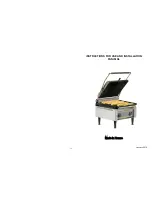
English |
15
Keyless chuck (see figure B)
Hold the rear sleeve
(3)
of the keyless chuck
(1)
firmly and
turn the front sleeve
(2)
in rotational direction
➊
until the
tool can be inserted. Insert the tool.
Hold the rear sleeve
(3)
of the keyless chuck
(1)
and firmly
tighten the front sleeve
(2)
by hand in rotational direction
➋
until you hear a click. This will automatically lock the drill
chuck.
The lock will disengage again if you turn the front sleeve
(2)
in the opposite direction to remove the tool.
Keyed chuck (see figure C)
Open the keyed chuck
(13)
by turning it until the tool can be
inserted. Insert the tool.
Insert the chuck key
(12)
into the corresponding holes of the
keyed chuck
(13)
and clamp the tool evenly.
Keyless chuck with securing ring (see figure D)
Turn the securing ring
(19)
in the "UNLOCK" direction.
Turn the clamping sleeve
(18)
clockwise until the applica-
tion tool can be inserted.
Fully insert the application tool, hold it in the tool holder and
turn the clamping sleeve
(18)
anticlockwise firmly by hand
to tighten it. When doing so, hold the holding ring
(20)
firmly
in place.
Turn the securing ring
(19)
in the "LOCK" direction.
Note:
When using small drill bits, adjust the tool holder to
the rough drilling diameter first. Otherwise, there is a risk
that the drill bit will not be centred properly.
Removing the application tool
Turn the securing ring
(19)
in the "UNLOCK" direction.
Turn the clamping sleeve
(18)
clockwise until the applica-
tion tool can be removed.
Screwdriving Tools (see figure E)
You should always use a universal bit holder
(15)
when using
screwdriver bits
(14)
. Only use screwdriver bits that fit the
screw head.
Changing the drill chuck
u
Pull the plug out of the socket before carrying out any
work on the power tool.
Removing the securing screw
A securing screw
(16)
protects the keyless chuck
(1)
/keyed
chuck
(13)
from being accidentally separated from the drill
spindle. Open the keyless chuck
(1)
/keyed chuck
(13)
fully
and unscrew the securing screw
(16)
clockwise.
Note that
the securing screw has a left-hand thread.
If the securing screw
(17)
is stuck, place a screwdriver on
the screw head and loosen the securing screw by hitting the
handle of the screwdriver.
Removing the keyed chuck (see figure F)
To remove the keyed chuck
(13)
, place an open-ended
spanner
(17)
(width across flats: 17) onto the spanner flat
of the drive spindle.
Place the power tool on a firm surface, e.g. a work bench.
Insert the chuck key
(12)
into one of the three drilled holes
in the keyed chuck
(13)
and loosen the keyed chuck
(13)
us-
ing this lever by turning it anticlockwise. A stuck keyed chuck
can be loosened by gently hitting the chuck key
(12)
.
Remove the chuck key
(12)
from the keyed chuck and fully
unscrew and remove the keyed chuck.
Dismounting the keyless chuck/keyless chuck with
securing ring
To remove the keyless chuck and the keyless chuck with se-
curing ring, clamp a hex key in the keyless chuck and posi-
tion an open-ended spanner (width across flats: 17) against
the spanner flat of the drive spindle.
Place the power tool on a firm surface, e.g. a work bench.
Hold the open-ended spanner
(17)
tightly and loosen the
keyless chuck by turning the hex key anticlockwise. A stuck
keyless chuck can be loosened by gently hitting the long
shaft of the hex key.
Remove the hex key from the keyless chuck
(1)
and fully un-
screw the keyless chuck
(1)
from the power tool.
Fitting the drill chuck
The fitting of the keyless chuck/keyless chuck with securing
ring/keyed chuck takes place in reverse order.
The drill chuck must be tightened using a tight-
ening torque of approx. 50–55 Nm.
For keyless/keyed chucks
Screw the securing screw
(16)
anticlockwise into the open
keyless/keyed chuck.
Always use a new securing screw, as their thread is applied
with a securing adhesive substance, which is rendered inef-
fective after several uses.
Dust/Chip Extraction
Dust from materials such as lead-containing coatings, some
wood types, minerals and metal can be harmful to one’s
health. Touching or breathing-in the dust can cause allergic
reactions and/or lead to respiratory infections of the user or
bystanders.
Certain dust, such as oak or beech dust, is considered carci-
nogenic, especially in connection with wood-treatment ad-
ditives (chromate, wood preservative). Materials containing
asbestos may only be worked by specialists.
– Provide for good ventilation of the working place.
– It is recommended to wear a P2 filter-class respirator.
Observe the relevant regulations in your country for the ma-
terials to be worked.
u
Avoid dust accumulation at the workplace.
Dust can
easily ignite.
Operation
Starting Operation
u
Pay attention to the mains voltage. The voltage of the
power source must match the voltage specified on the
Bosch Power Tools
1 609 92A 5H2 | (20.11.2019)
















































